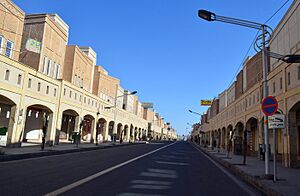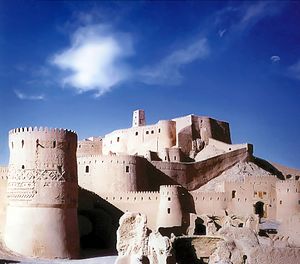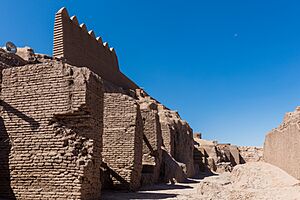Bam, Iran facts for kids
Quick facts for kids
Bam
Persian: بم
|
|
|---|---|
|
City
|
|

Bam in 2013
|
|
| Country | Iran |
| Province | Kerman |
| County | Bam |
| District | Central |
| Elevation | 1,061 m (3,481 ft) |
| Population
(2016)
|
|
| • Urban | 127,396 |
| Time zone | UTC+3:30 (IRST) |
| UNESCO World Heritage Site | |
| Official name | Bam and its Cultural Landscape |
| Criteria | Cultural: ii, iii, iv, v |
| Inscription | 2004 (28th Session) |
| Endangered | 2004–2013 |
Bam (pronounced "Bam") is a city in Iran, located in the Kerman area. It is the main city of Bam County. The modern city of Bam is built around the famous Bam Citadel. Before a big earthquake in 2003, about 43,000 people lived there.
People have different ideas about when and why the citadel was first built. Bam was once a very important trading city. It was well-known for its amazing fabrics and clothes. An Arab traveler named Ibn Hawqal wrote about Bam between 943 and 977 AD. He said that Bam made excellent cotton cloths that were sent all over the world. They also made expensive clothes that were sold in places like Iraq and Egypt.
Contents
History of Bam
Ancient Times
The ancient Arg-e Bam citadel is about 2,000 years old. It dates back to the Parthian Empire (248 BC–224 AD). However, most of its buildings were constructed much later, during the Safavid dynasty. This citadel was a huge draw for visitors. It is now a World Heritage Site recognized by UNESCO.
The city was mostly left empty after an invasion by Afghan forces in 1722. Later, people slowly moved back to Bam. But it was abandoned again after another attack from Shiraz. For a while, it was even used as an army camp.
Modern Bam
The modern city of Bam has grown into a center for farming and industry. Before the 2003 earthquake, it was growing very quickly. Bam is especially famous for its delicious dates and citrus fruits. These are grown using a large system of underground water channels called qanats.
One of the most important farm products is the Bam Mozafati date. These dates are famous in Iran and other countries. They have a delicate, rich, and sweet taste. They are harvested every year in the mountainous Darbam region. No chemicals or preservatives are added to them. They are a fresh, natural, and high-quality product.
The city also became popular for tourism. More and more people visited the old citadel in the years before the earthquake.
The 2003 Earthquake

A powerful earthquake hit Bam on December 26, 2003. It happened early in the morning, at 5:26 AM local time. Scientists say the earthquake had a strength of 6.6 on the moment magnitude scale. It caused a lot of damage. Sadly, over 26,000 people died, and 30,000 more were hurt.
The earthquake was so destructive for a few reasons. Many buildings in Bam were made of mud bricks. These buildings were not strong enough to handle an earthquake. Also, most people were asleep when the main shaking started.
After the earthquake, many countries sent help to Bam. Over 40 countries sent people to help with rescue efforts. More than 60 countries offered support.
Rebuilding Bam
Right after the 2003 earthquake, the Iranian government started planning a new city. They wanted to fix the problems that the old city had. It took about six months to create the plan. Even though there were some complaints, the government continued with its plans. Today, the city is being rebuilt. The famous citadel is also being carefully restored by experts. The earthquake was a terrible event that stopped Bam's growth for a while. About half of the city's people died, and most of the rest were injured. The cost of the damage was very high, estimated to be up to 1 billion US dollars.
2007 Sandstorm
On March 16, 2007, a very strong sandstorm hit Bam without warning. The winds reached about 130 kilometers per hour (81 miles per hour). Three children sadly died from suffocation, and two people died in car accidents. Fourteen others were injured.
People of Bam
Population Growth
The number of people living in Bam has changed over the years.
- In 2006, there were about 73,823 people living in Bam.
- By 2011, the population grew to about 107,131 people.
- In 2016, the city's population was around 127,396 people.
Weather in Bam
Bam has a desert climate. This means it has very long, hot summers and short, mild winters. On average, the city gets only about 60 millimeters of rain each year.
| Climate data for Bam 1067m (1956–2010) | |||||||||||||
|---|---|---|---|---|---|---|---|---|---|---|---|---|---|
| Month | Jan | Feb | Mar | Apr | May | Jun | Jul | Aug | Sep | Oct | Nov | Dec | Year |
| Record high °C (°F) | 30.0 (86.0) |
33.2 (91.8) |
39.0 (102.2) |
39.6 (103.3) |
44.6 (112.3) |
47.6 (117.7) |
46.8 (116.2) |
47.0 (116.6) |
43.6 (110.5) |
40.0 (104.0) |
34.2 (93.6) |
32.0 (89.6) |
47.6 (117.7) |
| Mean daily maximum °C (°F) | 16.5 (61.7) |
19.7 (67.5) |
24.7 (76.5) |
30.2 (86.4) |
35.3 (95.5) |
39.2 (102.6) |
39.6 (103.3) |
38.2 (100.8) |
35.4 (95.7) |
30.6 (87.1) |
23.8 (74.8) |
18.4 (65.1) |
29.3 (84.7) |
| Daily mean °C (°F) | 10.7 (51.3) |
13.6 (56.5) |
18.5 (65.3) |
23.8 (74.8) |
28.8 (83.8) |
32.8 (91.0) |
33.6 (92.5) |
32.0 (89.6) |
28.9 (84.0) |
24.0 (75.2) |
17.5 (63.5) |
12.4 (54.3) |
23.0 (73.4) |
| Mean daily minimum °C (°F) | 4.8 (40.6) |
7.6 (45.7) |
12.3 (54.1) |
17.4 (63.3) |
22.4 (72.3) |
26.4 (79.5) |
27.6 (81.7) |
25.8 (78.4) |
22.3 (72.1) |
17.4 (63.3) |
11.2 (52.2) |
6.4 (43.5) |
16.8 (62.2) |
| Record low °C (°F) | −9.0 (15.8) |
−5.0 (23.0) |
−3.0 (26.6) |
4.0 (39.2) |
9.5 (49.1) |
18.0 (64.4) |
19.0 (66.2) |
15.0 (59.0) |
11.0 (51.8) |
6.0 (42.8) |
−2.0 (28.4) |
−7.0 (19.4) |
−9.0 (15.8) |
| Average precipitation mm (inches) | 12.0 (0.47) |
8.9 (0.35) |
12.2 (0.48) |
9.7 (0.38) |
5.5 (0.22) |
0.6 (0.02) |
0.9 (0.04) |
0.6 (0.02) |
0.2 (0.01) |
0.9 (0.04) |
2.2 (0.09) |
5.1 (0.20) |
58.8 (2.31) |
| Average precipitation days (≥ 1.0 mm) | 2.1 | 1.8 | 2.7 | 2.3 | 1.1 | 0.2 | 0.1 | 0.1 | 0.1 | 0.4 | 0.6 | 1.2 | 12.7 |
| Average snowy days | 0.4 | 0.1 | 0.0 | 0.0 | 0.0 | 0.0 | 0.0 | 0.0 | 0.0 | 0.0 | 0.0 | 0.2 | 0.7 |
| Average relative humidity (%) | 46 | 41 | 36 | 31 | 26 | 21 | 21 | 21 | 22 | 27 | 34 | 42 | 30 |
| Mean monthly sunshine hours | 234.1 | 223.8 | 239.5 | 258.3 | 311.2 | 331.4 | 338.4 | 336.8 | 306.6 | 296.8 | 260.4 | 240.2 | 3,377.5 |
| Source: Iran Meteorological Organization (records), (temperatures), (precipitation), (humidity), (days with precipitation),
(sunshine) |
|||||||||||||
Universities in Bam
Bam is home to several important universities:
- Bam University: This is a respected school that offers courses for undergraduate students.
- Bam University of Medical Sciences: This is one of the most important universities in the city, focusing on medical studies.
- Islamic Azad University, Bam branch: This branch is considered one of the top universities in Bam.



